 |
| Interactive Camp Map with Photos * |
The forced labour camp in Poniatowa was located 30 km west of
Lublin.
Shortly before
1939 the Polish authorities started to build an equipment
factory in Poniatowa for the Polish army signal service. The settlement
for the factory staff (21 blocks) and the first industrial buildings were
built in the forest close to the village of Poniatowa. A narrow-gauge
railway was also built which connected Poniatowa with
Opole Lubelskie
and the main railway station in
Naleczow. The outbreak of the war prevented
the factory from being opened. The German
Wehrmacht used the buildings as an army base up until
1941.
In
September 1941 the Nazis decided to use these buildings as a camp for
25,000 Soviet POWs. The factory was surrounded by barbed wire and 16 watch
towers. It became
Stalag 359 (
Stalag = Stammlager). The transports of Soviet
POWs arrived at
Naleczow railway station from where the Soviet soldiers had to
walk to Poniatowa. They were maltreated on the way to the camp and many died.
Between September and December 1941 almost 24,000 Soviet POWs were deported to Poniatowa.
 |
| Narrow Gauge Ramp * |
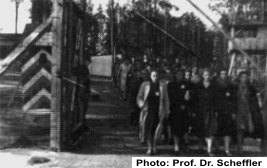 |
| Main Gate |
The prisoners lived in the factory buildings which were not suited to
accommodate such large numbers. Some prisoners had to live in the open.
The conditions were very unhygienic; there was no possibility of washing
or changing clothes. Many of the Soviet POWs died from a typhus epidemic
and from hunger. They were employed building new barracks and a water supply.
At the
beginning of 1942 the mortality in the camp was at its highest,
almost 1,000 people died daily. In the
spring of 1942 only 500 Soviet POWs
remained alive in the camp. These survivors (mainly
Volksdeutsche) decided
to join the SS units which were trained in the SS training camp in
Trawniki.
This Soviet POW camp was then liquidated. Those around 22,000 prisoners who had died or
been murdered, were buried in 32 mass graves within the environs of the camp.
In
October 1942
Amon Göth, (later the commandant of the
Plaszow forced labour camp in
Krakow came to Poniatowa
and started to organize a work camp for Jewish prisoners. The establishment of the Jewish work camp was a part of
Aktion Reinhard and in correspondence with
Heinrich Himmler's special order about
using able bodied Jews for war production.
Goeth decided that the Poniatowa camp
should be able to absorb around 9,000 Jewish prisoners. See the
map of Zentralbauleitung der SS und Polizei
of the planned camp layout.
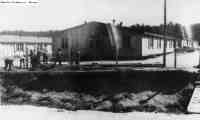 |
| Camp Barracks * |
The camp was divided into three sections: the factory buildings, the
administration and the prisoner barracks. 30 barracks were built within
the environs of the camp. The first Jewish prisoners were deported to Poniatowa
from the ghetto in
Opole Lubelskie (the main transit ghetto in the
Pulawy district) in
October 1942. They were selected
Jews, mainly from
Wien and Slovakia. The largest number of Jewish prisoners
arrived at the camp during the
Warsaw Ghetto uprising in
April - May 1943.
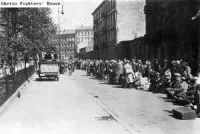 |
Deportation from Toebbens Factory.
Warsaw, Ul. Prosta. Spring 1943 * |
This group of around 15,000
Jews had worked for the
Walter Toebbens Company in the
Warsaw Ghetto.
Small transports from
Toebbens Company were sent to Poniatowa already in
February and March 1943 and the German industrialist personally encouraged
the Jewish workers to relocate to Poniatowa, arguing that it is only means
to survival.
Toebbens had good relations with
Odilo Globocnik. He agreed
with
Globocnik that his factories and workshops from the ghetto could be
part of
Osti Company, established by
Globocnik and the SS in
January 1943 for the better exploitation of the Jewish workers in the
Lublin district and better plunder of Jewish property in the
Generalgouvernement.
It is important to know that the
Toebbens Company was the biggest one in the
Warsaw
Ghetto at that time. Smaller groups of Jewish prisoners were brought to Poniatowa
from the
Belzyce and
Staszow Ghettos and in
May 1943 a group of 807 Jews were selected at the
Treblinka death camp for work in Poniatowa. The Jewish prisoners
who were deported to Poniatowa were mainly specialist workers or young people
able to work. However often entire Jewish families with their children were
at Poniatowa. There were also rich and influential people from the
Warsaw Ghetto among them, for example the families of
Judenrat members.
There was also a large group of doctors, artists, former industrialists and merchants from
Warsaw in the Poniatowa camp. The most privileged group were Austrian
and Slovakian Jews who occupied the best functions in the camp and who were
in many cases accused of being collaborators by the Polish Jews.
The camp elite, around 3,000 prisoners, lived in the "Settlement", together
with their families. The living conditions were better here and they had the
possibility of trading with Polish farmers from the neighbouring villages.
They also had a theatre and a communal kitchen.
The largest group of prisoners lived in a hall and 30 barracks in the environs
of the factory. Men, women and children lived together in this totally
overcrowded space. There was an average of 300 prisoners to a barrack.
The worst conditions were in the factory hall where thousands of prisoners
lived. There were only four water taps. The conditions were filthy and the air fetid.
In the
camp kitchen the prisoners got their daily food ration:
coffee without sugar for breakfast, watery soup for lunch and 250 grams bread and coffee for dinner.
The non-working prisoners only received 100 grams bread and coffee. Those people who still
had money bought extra food on the black market where the prices for the smuggled food were
50 % higher than the official price.
 |
| Sewing Workshop * |
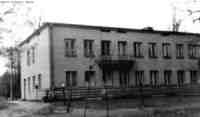 |
| SS Building
* * |
Most of the prisoners, around 10,000 people, worked for the
Toebbens Company,
mainly producing textiles and leather products or sorting the clothes
belonging to the victims of
Aktion Reinhard. The production of the
Toebbens factories
in Poniatowa was totally connected with army supplies. The biggest part of the
workers at
Toebbens sewed uniforms for the German army. They were treated
better than the other prisoners. The prisoners who had numbers higher than 10,000
worked for the SS, they built barracks, streets and water channels or cut
trees in the forest. Here the work was arduous and the treatment of the
prisoners more brutal.
Until
August 1943 the conditions in the Poniatowa camp were more liberal. Some
prisoners had the possibility of smuggling food into the camp. The SS organized
this to demonstrate that not all Jews were killed and that specialist workers
had a chance of survival. In
August 1943 Poniatowa was visited by
Odilo Globocnik and from that time on the prisoners were treated as concentration
camp prisoners. Any breach of camp regulations was punished by death. Very
often the SS applied collective responsibility, for example when one prisoner
escaped, a group of prisoners were executed. Several people were killed daily.
The bodies of the murdered prisoners were burned in a primitive crematorium.
This was an iron bed under which a fire was lit. The "real" crematorium was
still under construction.
The SS staff in the camp had previously served at the
Belzec death camp.
SS-Obersturmführer Gottlieb Hering, the last
commandant of
Belzec, became commandant of Poniatowa in
spring 1943. His
deputy was
Wallerang, named "Glove" by the prisoners because he usually wore
white gloves. The main executioner in the camp was
Heinrich Gley, also an
SS man from
Belzec. The entire SS staff numbered 40 people. The civil director
of the factory was
Ernst Jahn, a
Volksdeutscher, former Polish citizen who
spoke Polish,
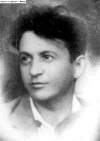 |
| Fajnkind * |
German, English and Hebrew fluently. He openly resisted the SS men in the camp and was
probably killed by the SS in
Tomaszow Mazowiecki before the camp was liquidated.
His successor was
Bauch who participated in the execution of prisoners.
Other
Aktion Reinhard men who served in Poniatowa:
Ernst Zierke, Hans Zänker, and
Robert
Jührs.
Among the Ukrainian guards who were in Poniatowa, were also
Trawniki men from
Belzec death camp.
There were many resistance fighters from the
Warsaw Ghetto among the prisoners.
They organized the Jewish Fighting Organisation inside the camp with
Majlech
Fajnkind as its commander. The JFO had contact with the Jewish underground
in
Warsaw and "Zegota", the Council for Aid to Jews in Occupied Poland. Thanks
to these contacts money, medicine, instructions and weapons were smuggled into
the camp. "Aryan" ID-cards were counterfeited for Jews planning escape. Most
escapees went to
Warsaw (the escapees who survived the war became the authors
of the memoirs about the camp). The Jewish and Polish underground published
reports about Poniatowa which remain the best source of the history of the
camp. The camp's underground planned several actions against the SS-men but
the JFO in Poniatowa was insufficiently equipped for larger actions.
 |
| The outer Double Fence |
The camp in Poniatowa was liquidated on
4 November 1943, during the
Aktion Erntefest
("Action Harvest Festival"). Several days before their mass execution the
prisoners had to dig their own mass graves. Some ditches were dug inside the
camp, in front of the camp administration building, others outside the camp,
three miles from
Wronow Street. The prisoners were informed that they had to
build air-raid shelters (
Splittergräben). At 5 a.m. on
4 November 1943, all
prisoners were assembled in a roll call. They were ordered to a large shop.
All of them were crammed into that bulding. From time to time the SS got groups
of 50 Jews out of the shop. In the open air they had to take off their shoes
and put their valuables into baskets. In a nearby barrack they were ordered to
undress, then led to the ditches. The victims had to lie down on the bottom of the ditch,
faces downwards. Then they were shot. During the executions music was played from
loudspeaker vehicles to cover the screams and shots.
In one barrack, where the members of the camp's underground were gathered,
they began to shoot at the SS men. The SS set fire to the barrack and the
entire group of fighters was burned alive. Polish firemen from
Opole Lubelskie
witnessed this, having seen the smoke over the camp. Around 14,000 people were shot that day. A group of 150 - 200
selected Jews were ordered to burn the bodies. They refused it and were executed likewise. The members of the
Sonderkommando from
Majdanek and the Jewish prisoners, selected
during the
Aktion Erntefest at
Majdanek, were therefore transferred to
Poniatowa where they sorted the clothes of the victims and burned the bodies over the following several weeks.
There are only two known testimonies of survivors of the
Erntefest executions in
Poniatowa. After the war two women,
Estera Rubinsztajn and Ludwika Fiszer
wrote their memoirs about this mass execution. Both survived beneath the bodies of others killed in Poniatowa.
Today in Poniatowa there are six memorials, but without mentioning the Jewish work
camp and the
Aktion Erntefest executions.
Photos:
GFH
*
Artur Podgorski
*
Sources:
Testimonies from the Jewish Historical Institute in Warsaw.
Reports by the Jewish and Polish underground, deposited in the Jewish Historical Institute in Warsaw.
Documentation of the investigations, organized by the Commission for the Investigation of Nazi Crimes in
Lublin in 1947 and 1967. Institute for the National Remembrance in Lublin and State Museum Majdanek.
Testimony by Ludwika Fiszer:
www.zchor.org/poniatowa/fiszer.htm
Tatiana Berenstein: Obozy pracy przymusowej dla Zydow w dystrykcie lubelskim (The Compulsory Work Camps
for the Jews in Lublin District). "Biuletyn ZIH", 1957, nr 54.
Nachman Blumental: Materialy i dokumenty z czasow okupacji niemieckiej w Polsce (The Materials and
Documents from the Time of the German Occupation in Poland). Vol. I, Obozy (The Camps). Lodz 1946.
Ryszard Gicewicz: Oboz pracy w Poniatowej 1941-1943 (The Work Camp in Poniatowa 1941-1943).
"Zeszyty Majdanka", Vol. X (1980).
Special thanks to Artur Podgorski, Poland, for his great support.
© ARC 2005

















